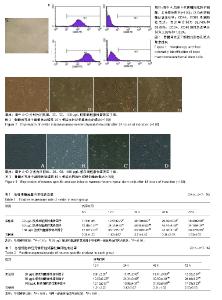| [1]Friedenstein AJ, Gorskaja JF, Kulagina NN. Fibroblast precursors in normal and irradiated mouse hematopoietic organs. Exp Hematol. 1976;4(5):267-274.[2]Kang JG, Park SB, Seo MS, et al. Characterization and clinical application of mesenchymal stem cells from equine umbilical cord blood. J Vet Sci. 2013;14(3):367-371.[3]Lotfy A, Salama M, Zahran F, et al. Characterization of mesenchymal stem cells derived from rat bone marrow and adipose tissue: a comparative study. Int J Stem Cells. 2014;7(2):135-142.[4]Gattei V, Celetti A, Cerrato A, et al. Expression of the RET receptor tyrosine kinase and GDNFR-alpha in normal and leukemic human hematopoietic cells and stromal cells of the bone marrow microenvironment. Blood. 1997;89(8):2925-2937.[5]熊怀林,邓莉,高小青,等.胶质源性神经营养因子基因修饰骨髓间充质干细胞与缺氧复氧神经细胞的共培养[J].中国组织工程研究与临床康复, 2011, 15(49):9141-9145.[6]Liu Q, Cheng G, Wang Z, et al. Bone marrow-derived mesenchymal stem cells differentiate into nerve-like cells in vitro after transfection with brain-derived neurotrophic factor gene. In Vitro Cell Dev Biol Anim. 2015;51(3):319-327.[7]Marcoli M, Candiani S, Tonachini L, et al. In vitro modulation of gamma amino butyric acid (GABA) receptor expression by bone marrow stromal cells. Pharmacol Res. 2008;57(5):374-382.[8]Farhi J, Ao A, Fisch B, et al. Glial cell line-derived neurotrophic factor (GDNF) and its receptors in human ovaries from fetuses, girls, and women. Fertil Steril. 2010;93(8):2565-2571.[9]刘振东,王静成,杨建东.骨髓间充质干细胞向神经细胞分化的相关信号通路研究现状[J].中国组织工程研究, 2012,16(6):1111-1114. [10]Fedyanin M, Anna P, Elizaveta P, et al. Role of Stem Cells in Colorectal Cancer Progression and Prognostic and Predictive Characteristics of Stem Cell Markers in Colorectal Cancer. Curr Stem Cell Res Ther. 2017;12(1):19-30.[11]Abreu Velez AM, Upegui Zapata YA, Howard MS. Periodic Acid-Schiff Staining Parallels the Immunoreactivity Seen By Direct Immunofluorescence in Autoimmune Skin Diseases. N Am J Med Sci. 2016;8(3):151-155.[12]徐丽丽,王洪元,李学达,等. 共培养方法诱导3种间充质干细胞向神经细胞分化的比较[J].中国组织工程研究, 2017,21(17):2714-2721.[13]Bao X, Ren T, Huang Y, et al. Bortezomib induces apoptosis and suppresses cell growth and metastasis by inactivation of Stat3 signaling in chondrosarcoma. Int J Oncol. 2017;50(2):477-486.[14]Lim JY, Park SI, Oh JH, et al. Brain-derived neurotrophic factor stimulates the neural differentiation of human umbilical cord blood-derived mesenchymal stem cells and survival of differentiated cells through MAPK/ERK and PI3K/Akt-dependent signaling pathways. J Neurosci Res. 2008;86(10):2168-2178.[15]Delcroix GJ, Curtis KM, Schiller PC, et al. EGF and bFGF pre-treatment enhances neural specification and the response to neuronal commitment of MIAMI cells. Differentiation. 2010;80(4-5): 213-227.[16]Pollock K, Stewart H, Cary W, et al. Human Mesenchymal Stem/Stromal Cells Engineered to Produce Brain-derived Neurotrophic Factor for the Future Treatment of Huntington's Disease. Neurotherapeutics. 2015;12(1):274.[17]Musa ZA, Qasim BJ, Ghazi HF, et al. Diagnostic roles of calretinin in hirschsprung disease: A comparison to neuron-specific enolase. Saudi J Gastroenterol. 2017;23(1):60-66.[18]Fei J, Gao L, Li HH, et al.Electroacupuncture promotes peripheral nerve regeneration after facial nerve crush injury and upregulates the expression of glial cell-derived neurotrophic factor.Neural Regen Res. 2019;14(4):673-682.[19]Anitha M, Chandrasekharan B, Salgado JR, et al. Glial-derived neurotrophic factor modulates enteric neuronal survival and proliferation through neuropeptide Y. Gastroenterology. 2006;131(4): 1164-1178.[20]Naderi N. The Perspectives of Mesenchymal Stem Cell Therapy in the Treatment of Multiple Sclerosis. Iran J Pharm Res.2015;14(Suppl):1-2.[21]Park D, Xiang AP, Mao FF, et al. Nestin is required for the proper self-renewal of neural stem cells. Stem Cells. 2010;28(12):2162-2171.[22]Sherief LM, Beshir M, Salah HE. Neuron-specific enolase in cerebrospinal fluid as a neurochemical marker for brain damage in acute lymphoblastic leukemia. Egypt J Haematol. 2016;41(2):77-80.[23]Jori FP, Napolitano MA, Melone MA, et al. Molecular pathways involved in neural in vitro differentiation of marrow stromal stem cells. J Cell Biochem. 2005;94(4):645-655.[24]Ramasamy S, Narayanan G, Sankaran S, et al. Neural stem cell survival factors. Arch Biochem Biophys. 2013;534(1-2):71-87.[25]Wei L, Fraser JL, Lu ZY, et al. Transplantation of hypoxia preconditioned bone marrow mesenchymal stem cells enhances angiogenesis and neurogenesis after cerebral ischemia in rats. Neurobiol Dis. 2012;46(3):635-645.[26]Yuan J, Huang G, Xiao Z, et al. Overexpression of β-NGF promotes differentiation of bone marrow mesenchymal stem cells into neurons through regulation of AKT and MAPK pathway. Mol Cell Biochem. 2013;383(1-2):201-211.[27]Ding Y, Yan Q, Ruan JW, et al. Electroacupuncture promotes the differentiation of transplanted bone marrow mesenchymal stem cells overexpressing TrkC into neuron-like cells in transected spinal cord of rats. Cell Transplant. 2013;22(1):65-86.[28]Zaim M, Karaman S, Cetin G, et al. Donor age and long-term culture affect differentiation and proliferation of human bone marrow mesenchymal stem cells. Ann Hematol. 2012;91(8):1175-1186. |

